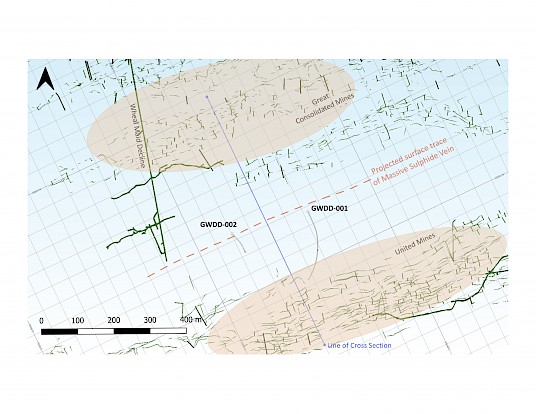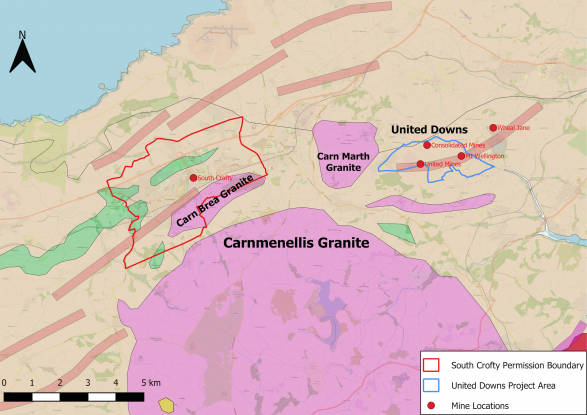South Crofty and United Downs Mine Locations
With the acquisition of the South Crofty tin project in July 2016, Cornish Metals also acquired additional mineral rights in Cornwall, UK. The additional mineral rights cover an area of approximately 15,000 hectares and are scattered throughout Cornwall and include the United Downs Project. United Downs is located approximately 8km east of South Crofty and lies within a densely mined district, historically referred to as Gwennap. Gwennap was the richest copper producing region in Cornwall (and the world) in the 18th and early 19th centuries, and at that time was referred to as “the richest square mile on earth”.
United Downs Project - an Overview
The United Downs project covers, or is located immediately adjacent to, four former copper and tin producing mines: Consolidated Mines and United Mines to the west; and Mount Wellington and Wheal Jane Mines to the east. The main mineralised structures in all four mines trend ENE and dip steeply to the north. All of the mineralisation exploited historically is related to either quartz veins or quartz-tourmaline veins hosted within “killas”, the local name for metasedimentary rocks that overlie granite intrusions.
At the nearby South Crofty Mine, copper-tin-zinc-tungsten mineralisation hosted within the killas passes into tin mineralisation at depth as the mineralised vein-like structures pass into the underlying granitic host rock. The same zonation potentially exists at United Downs, where only the killas-hosted mineralisation has been exploited to date. The underlying granite, which is a target for further tin mineralisation, was encountered in GWDD-002 between 300 and 600 metres and again at 700 metres vertical depth.
The nearby Wheal Jane mine was discovered and developed into a modern mine in the late 1960s, initially by Consolidated Goldfields, and thereafter by Rio Tinto Zinc. Mining activities at Wheal Jane ceased in early 1991, due largely to the Tin Crisis of 1985, but processing of South Crofty ore continued until March 1998 when ongoing low tin prices forced its eventual closure.
As part of the intense exploration period that Cornwall enjoyed between the 1960s and 1985, an underground exploration drive was developed during the 1980s westwards from Wheal Jane through Mount Wellington mine at 6 level elevation, whilst an exploration decline (the Wheal Maid decline) was developed to explore for tin mineralisation similar in style to that which was exploited in Mount Wellington and Wheal Jane mines. This exploration work was stopped after the tin price collapse in 1985, despite the great promise for the discovery of polymetallic mineralisation
A New Copper Tin Discovery
In April 2020, Cornish Metals reported the discovery of a new zone of high-grade copper-tin mineralisation located in a previously unmined area between the historic United Mine and Consolidated Mines at United Downs. Two diamond drill holes were completed, for a total length of 1,858 metres. In November 2020, Cornish Metals reported the second set of assays, including 4.04 metres grading 4.44% Copper and 2.06% Tin.
In 2021, Cornish Metals commenced with a 10,159 metre drilling programme at the United Downs project. The programme was designed to follow up from the 2020 drilling programme, with the first 3,927 metres intersecting two zones of high-grade mineralisation of tin and copper. The assay results for the drilling programme as a whole confirmed management’s belief in the potential to develop a Mineral Resources in the project area.
Highlights of the Drilling Programmes:
- Assay results from the 10,000 metres drilling programme confirmed management’s belief in the potential to develop a Mineral Resource in the United Downs project area
- Multiple zones of copper-tin-silver-zinc mineralisation were intersected
- High-grade copper-tin mineralisation was intersected down dip beneath the historic United Mines
- In early 2020, a diamond drilling programme was conducted at United Downs, and a second set of assay results confirmed multiple zones of copper and / or tin mineralisation were intersected
- Mineralisation extended over at least 750 metre vertical extent and is open along strike and to depth
- Identified five new zones of copper and / or tin mineralisation
- Drill hole GWDD-002 intersected semi-massive sulphide mineralisation between 90.60 and 105.29 metres downhole depth
- Further drilling is required to confirm true width, as well as the strike and dip of the mineralised zone
- The semi-massive sulphide mineralisation is similar in style to that mined at Wheal Jane and Mount Wellington mines, located 1.5 km along strike to the east; and
- Copper grades reflect recorded historical mine production from United Mines located approximately 200 metres to the south.
All mineralised zones are tabulated below:
|
Hole ID |
From (m) |
To (m) |
Length (m) |
Copper (% Cu) |
Tin (% Sn) |
|
GWDD-001 |
621.90 |
628,81 |
6.91 |
0.81 |
|
|
Inc. |
625.00 |
627.75 |
2.75 |
1.08 |
|
|
GWDD-002 |
90.60 |
105.29 |
14.69 |
8.45 |
1.19* |
|
GWDD-002 |
513.33 |
515.78 |
2.45 |
|
0.90 |
|
Inc. |
513.33 |
513.65 |
0.32 |
|
3.57 |
|
GWDD-002 |
636.11 |
637.71 |
1.60 |
|
0.98 |
|
GWDD-002 |
638.85 |
642.89 |
4.04 |
4.44 |
2.06 |
|
GWDD-002 |
770.06 |
773.00 |
2.94 |
|
0.95 |
|
Inc. |
771.06 |
771.96 |
0.90 |
|
3.05 |
|
And |
781.02 |
782.90 |
1.88 |
|
0.90 |
|
Inc. |
781.02 |
782.00 |
0.98 |
|
1.39 |
* Reported April 15, 2020 – see company news release dated April 15, 2020
** Additional drilling is required to determine the true width of all reported mineralised zones

GWDD-001 and 002 Plan Map



